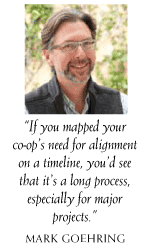When we examine the process of alignment and how it works, it seems straightforward. For example, board and management come together for learning and discussion about the future of the co-op and share an agreed-upon purpose. Of course, things don’t end there. But predicated upon board-management alignment is the awareness that what the board and management is doing is fulfilling the aspirations of the co-op’s ownership.

As food co-ops have grown, so has the diversity of membership, and the mandate, if you will, is much more wide-ranging. Some of the co-op’s stakeholders want access to local and organic food, others want a deeper connection to community, some want to change the economy, and others just want a place to pick up a sandwich or gallon of milk. Balancing the desires and comprehending the needs of different constituencies in order to vision the co-op’s future can feel daunting to boards.
Over the years, governance process has focused on relationships wherein boards can learn more about what owners are concerned about. Through engaging with the members, boards can gain greater knowledge, fueling the confidence that their decision-making process is in alignment with what owners want. Some of these activities are “high touch,” wherein board members hold scheduled meetings or have events where they talk directly with members—a board coffee klatch or a wine tasting.
These meetings can be deeply satisfying, but what if, after all that planning, only 10 or 50 people show up? What is the best use of the board’s energies regarding member relations? What is a sustainable and healthy approach to board-owner alignment? And what is the best way for a variety of owners to provide the feedback boards need? Especially as co-ops grow, the questions become much more pertinent.
The board should take opportunities for individual or small group interactions with owners. Learning from member feedback is invaluable, and finding ways to engage in two-way conversations in a successful and sustainable way is a critical part of board-owner alignment.
“What we have to realize is that it’s not just about the board and owners being aligned,” said Rose Marie Klee, board leadership development consultant, and board chair of Wheatsville Food Co-op in Austin, Texas. “All of us as individuals and groups have a role to play in overall alignment. The staff and management and board and owners all work together to establish effective ways to create alignment,” she said. “It’s a lot less stressful when you think about it that way.”
Klee cited as an example Wheatsville’s Ends regarding sustainability, hospitality and local and organic food. In the store, owners and shoppers may encounter information from staff or signage about products or food safety issues that may have a strong educational focus. “The board will talk about these same things at the values level in the newsletter. Through the work we are doing, we are connecting the dots on the impact owner and consumer choices have on the world and the community.” Customers are moved to act or invited to respond to these communication efforts, demonstrating their support (or not) for the co-op’s stated Ends. From Klee’s perspective, that’s how alignment around the same idea will be shared by owners, staff and board.
Mark Goehring, board leadership development consultant, noted that telling the co-op’s story in this way, through many channels, is an important part of creating alignment and generating greater participation. He also said that what works to create alignment “could look different in a moment of time or in a different organization” depending on the direction the co-op will take or the needs of the organization. He said there are times when co-op boards need active engagement to build shared understanding with owners, and other times when “being great storytellers” serves the purpose.

He also cautioned that strategic and intentional alignment is work wherein practitioners must take the long view. “If you mapped your co-op’s need for alignment on a timeline, you’d see that it’s a long process, especially for major projects. You’re putting decades on the table when you’re tallying real alignment.”
Klee said that the Wheatsville board reached that same conclusion during their second store development, especially because the work can seem so abstract. “Alignment is a process not a product,” she said about the board’s role. “I feel good about where we are now, but it’s still a work in progress. It’s not just about board-owner alignment, but the whole organization.” Both Klee and Goehring think that part of the stress or tension around board-owner alignment is an “old school” interpretation of what it means for boards to be productive.
“I’m interested in the idea of engaging with the co-op as part of a movement,” Klee said. She believes that redefining the concept of what is good in society is what positive movements, like cooperation, can do. The Wheatsville board wants to change the mindset in their community and beyond about the way business can be done, to demonstrate that it’s possible to be humane, fair and transparent, and be successful.
“There are other choices people can make that won’t have the same impact,” Klee said, so when people who do share the same business values are in alignment, the power of the movement is multiplied. “That’s the great work of the board. To imagine: what would the world be like if we all valued ethical business practices?”
Have more questions?
Get in touch with one of our consultants.
